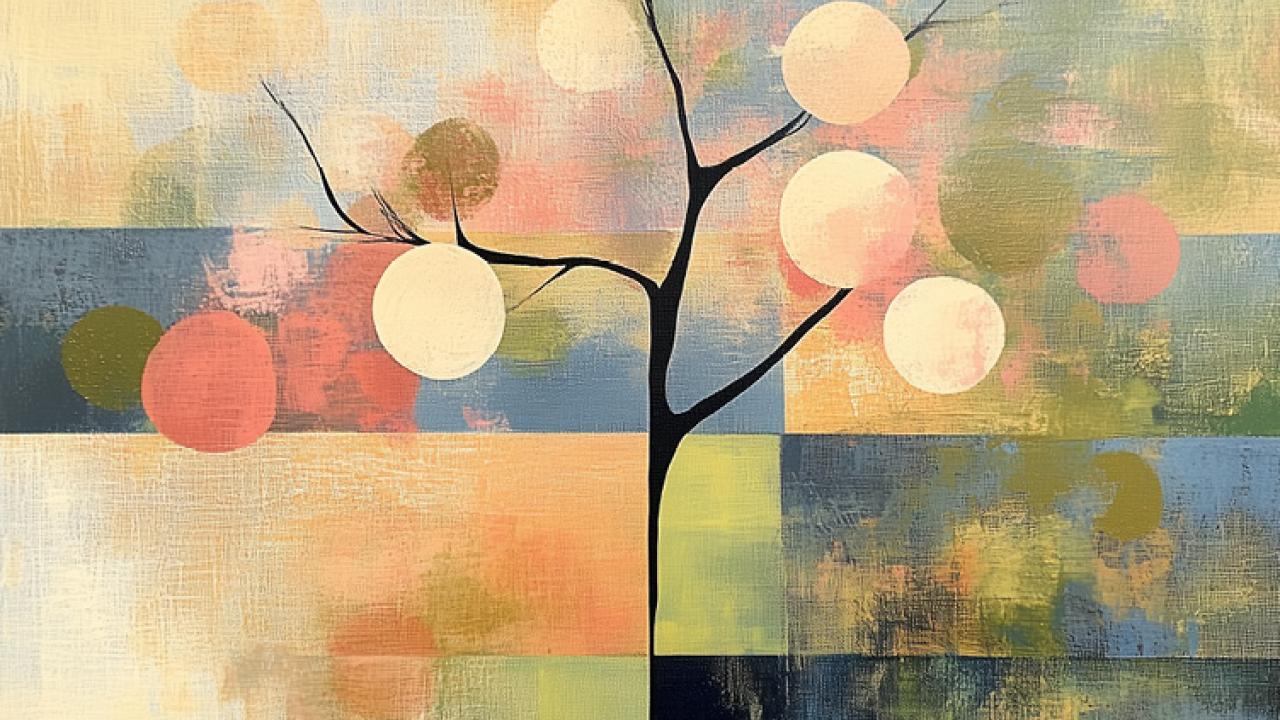Creating a banner is an excellent way to promote intergenerational interaction and involvement in worship. While this banner was fairly labor-and time-intensive, elements could be simplified to fit time or budget constraints.
It was five years ago that the Visual Arts Committee of Meadowlands Fellowship Church first started thinking about creating a banner using the tree of life from Revelation 21 and 22 as the main theme. The idea was to make a permanent banner that could be used at various times during the “Ordinary Time” seasons of the church year. The image of the tree of life is appropriate in those seasons, since it occurs throughout the Bible as a symbol of growth and of hope in the Christian journey.
The committee had considered various plans and drawings over the years, but it was not until 2010 that it decided to make the creation of this banner a collaborative effort. The size and scope of the project seemed ideal for congregational involvement. So the committee planned to invite the church to work on the banner during eight Sunday night meetings of the church’s Sunday night small groups, called OASIS.
The design fell into place once the group decided that the dominant feature of this tree would be the healing leaves. A subcommittee of four members worked on color schemes, fabric choices, timelines, and all the logistics of doing a project of this size with many people. They shopped for fabrics, made pattern pieces, figured out how many leaves would be needed for this project (five hundred) and made a schedule for the eight OASIS sessions.
It was extremely rewarding to work on this project in community. Leaves were cut at the annual women’s retreat, and when it was time to assemble the banner, people of all ages came to help. They talked with each other as they cut and sewed, some meeting each other for the first time. Some came just one time to work on writing the texts on fabric in their first or second language. Some attended all eight of the sessions, piecing and pinning and sewing. Almost all of the sewing was done by hand, and the work continued after the OASIS sessions were finished. By the time it was finished, more than fifty Meadowlands members had spent many hundreds of hours on the banner.
The Design
The banner’s design was based on texts that were chosen to represent both the Old and New Testaments:
- Ezekiel 47:12: “Fruit trees of all kinds will grow on both banks of the river. Their leaves will not wither, nor will their fruit fail. Every month they will bear fruit, because the water from the sanctuary flows to them. Their fruit will serve for food and their leaves for healing.”
- Revelation 22:1-2: “Then the angel showed me the river of the water of life, as clear as crystal, flowing from the throne of God and of the Lamb down the middle of the great street of the city. On each side of the river stood the tree of life, bearing twelve crops of fruit, yielding its fruit every month. And the leaves of the tree are for the healing of the nations.”
- Revelation 22:20: “He who testifies to these things says, ‘Yes, I am coming soon.’ Amen. Come, Lord Jesus.”
The project consisted of a 10 feet by 19 feet (3 m by 5.8 m) central panel that hung behind the pulpit; and six side panels stretched onto wooden frames, each 2.5 ft. x 2.5 ft. (76 cm by 76 cm), that we hung on the side walls of the sanctuary.
Sermon Notes
“On each side of the river stood the tree of life, bearing twelve crops of fruit, yielding its fruit every month” (Rev. 22:2).
“That person is like a tree planted by streams of water, which yields its fruit in season” (Ps. 1:3).
“The fruit of the righteous is a tree of life” (Prov. 11:30).
“A bruised reed he will not break” (Isa. 42:3).
How does one preach a sermon on a passage that can be taken in at least a dozen different directions, most of which have already been profoundly captured in an evocative banner? Which of these dozen possibilities does a congregation that has experienced two difficult funerals and is beginning a new season without a pastor need to focus on? When we answered that question at our church, the phrase “yielding its fruit every month” jumped off the page.
In the New Jerusalem, the tree of life is always in season, and there is no more death or mourning or crying or pain (Rev. 21:4). As children of the Lord we are led by the Holy Spirit “who is a deposit guaranteeing our inheritance” (Eph. 1:14). We bear fruit that points to the One who has redeemed us and is making all things new.
But we bear fruit in season. Sometimes we are the Proverbs 11 tree of life. At other times we are the Isaiah 42 bruised reed. During both times we can give thanks: We are thankful that we have the privilege of bearing fruit that anticipates the New Jerusalem. We are thankful that during seasons of drought and fruitlessness we can throw ourselves on the mercy of the Isaiah 42 servant and simply receive his grace.
Those thoughts led to two questions for our congregation: What season are you walking in today? How can the One who established the tree of life walk with you on the way to the New Jerusalem?
We also designed a pulpit parament and communion table runner to continue the “healing leaves” theme of the large banner.
We used fifty different fabrics, mostly in greens, browns, and blues, all sewn onto a solid blue-green background. Some areas were sewn flat (grassy background), while others were gathered into ridges (trunk) or folds (river). The leaves were tacked on to suggest fluttering. We also added various beads and sequins for sparkle and texture.
The three texts listed above were inscribed on the fabric of the tree trunk in twelve different languages: the Hebrew and Greek of the Old and New Testament passages, and ten languages representing the first and second languages of members of our congregation. The words can only be read close up, but they form the bark-like texture of the tree trunk. They also form the texture of the riverbanks on the six side panels. The tree and its trunk are formidable, and the foliage creates a beautiful, healthy, fruitful, and protective dome. The tree’s roots are partially visible and are nourished by the river of the water of life. Twelve fruits hang in the foliage, one for each month that the tree bears a crop.
The river of life flows abundantly out of the banner and into the worship space, continuing on the six coordinating panels on each side of the sanctuary. Floating down the river are the leaves of the tree that are for the healing of the nations. The beads on the leaves and the sequins in the water reflect the twenty-four hours of light in each day.
Edging the banner is the foundation wall that is mentioned in Revelation 21:19. Twelve jewel-tone fabrics represent the twelve layers of semiprecious stones in the foundation. The thirteenth jewel-tone, the pearl, represents the twelve gates that are in the city wall.
The words of Revelation 22:20 were added to the texts inscribed in the tree trunk to underline that this image speaks of our sure hope for the future. “He who testifies to these things says, ‘Yes, I am coming soon.’ Amen. Come, Lord Jesus.” The risen Lamb testifies that the future is secure. He has removed the barrier that kept us from the tree of life, and has given us access again. And he promises to return.
This project was completed at a time when our church’s pastorate had recently become vacant and the congregation had experienced various tragedies. The communal aspect of making the banner together, and hanging it in the belief that the leaves are for the healing of the nations (and of congregations), was poignant. We hope the banner will continue to be meaningful to many people in many different circumstances.
The Visual Arts Group
The Visual Arts Committee at Meadowlands Fellowship CRC was established in recognition that worship is multisensory and engages the worshiper in both emotive and rational ways.
The committee’s mandate was to set direction, assess needs, form working groups, purchase or commission or create pieces, maintain and catalog the growing collection of pieces, ensure that appropriate visuals are properly displayed, and be a resource for the worship team.
The policy that was adopted state that the visuals should reflect the liturgical calendar, since visuals and colors are linked to each of the cycles of the church year.
The group consists of seven church members who have various backgrounds in the arts and in worship and liturgy. Their skills complement each other, and they enjoy working as a team. Much of the design work is cooperative, and the group is often amazed by how things come together.
Many of the installations at Meadowlands are temporary and consist of 25-foot (7.5 m) lengths of fabrics of different colors and textures that hang behind the pulpit with a variety of images or objects suspended in front of them. The installations are suspended from a bar that can be lowered and raised using a pulley system. As the bar can be raised to many different heights, it works well for all of the pieces. The fabrics are pinned together so that they can be reused in different configurations at a later date. The large inventory of fabrics is stored in color-coordinated boxes.
Each year the committee identifies at least one new project. Some of these have been interactive with the congregation, while other projects have been made by the Visual Arts Committee themselves (usually adding a large piece to the permanent collection). Some pieces are either commissioned or purchased; these are usually smaller works and are displayed at the appropriate season in the church foyer and elsewhere throughout the building.
Three projects were created in conjunction with the senior Sunday school as part of their unit on worship. Two large mobiles, one with three-dimensional flames of different sizes and one with four hundred origami doves, were created in different years as graduation projects, around the time of Pentecost. A third project was creating twenty two-foot by two-foot (0.75 by 0.75 m) panels with colorful stars for Epiphany. These were suspended in four columns of five stars each. The stars have become a part of the permanent collection and are used at Epiphany every year.
Both the council and congregation of Meadowlands Fellowship are very supportive and appreciative of the committee’s work. The group can testify to the fact that this encouragement is received with great joy as they continue creating works and using their gifts to enhance worship through visuals.


